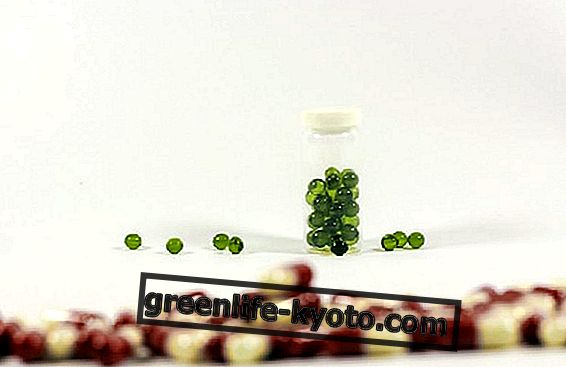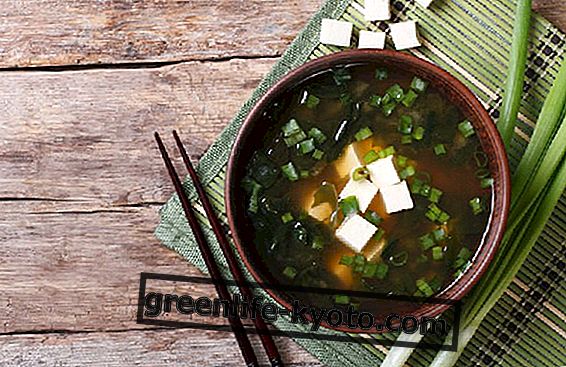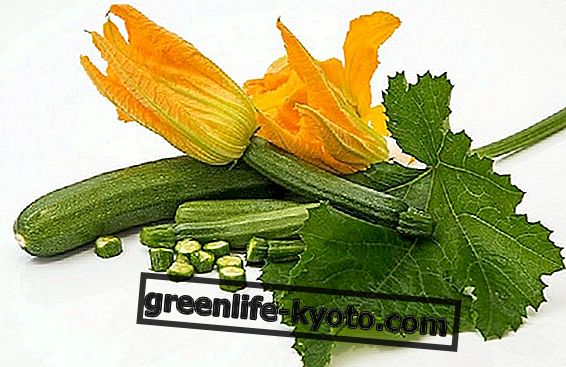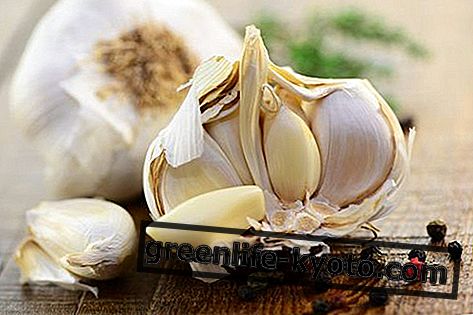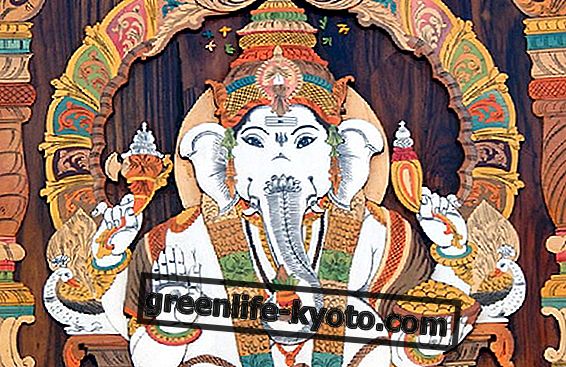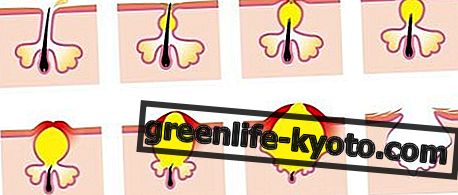
There are various types of headaches that afflict millions of people in the world and among these are above all women who are called into question, more than men. The "headache" is in fact, a disease that mainly affects the female sex, often occurring cyclically with the progress of menstruation and in any case in relation to the hormonal function ( headaches of menopause ) or in situations of work stress and sentimental.
The classification of headaches involves the identification of primary or essential forms when the pain of the headache does not find real causes and secondary forms in which the headache is the accompanying symptom of other pathologies such as ocular infections or paranasal sinuses, pathologies of the head, neuralgia or vascular disorders, etc. Let's see briefly some types.
Migraine
Migraine is defined as the headache in which intense and throbbing pain affects one side of the head, it is usually accompanied by other symptoms such as: nausea, vomiting, aversion to light and noise, dizziness and sometimes mental confusion.
The type of migraine with visual or sensory aura, that is, in which there are symptoms that precede migraine-like pain, is characteristic of essential primary headache (10% of headaches); in the remaining 60-70% of cases, the headache appears as an aura-free migraine, that is with more nuanced accompanying symptoms such as mood disorders, gastrointestinal symptoms, water retention etc .; in these cases the painful crisis can last even several days.
Muscle-tension headache
The term muscle-tension headache, on the other hand, defines a particular type of headache in which pain, not intense, is perceived as a weight or a narrow band around the head. It is the most common type of headache, it affects about 30-50% of the patients suffering from headache, with a prevalence for the female sex; it manifests itself by contraction of the neck and face muscles, with a pain that radiates to the nape of the neck and to the cervical region .
Cluster headache
Finally, the term cluster headache refers to a particular type of headache, which mainly affects the male sex, in which the violent pain affects half of the skull (migraine), involving the eye and the eyelid of the affected side . Painful crises occur with close attacks over time, even several times a day, at the same time and are long lasting (over 30 minutes). They are often associated with redness and watery eyes, nasal obstruction, sweating and a state of intense agitation. The most common triggers of this headache seem to be alcohol and long-lasting stress.
Vertebro-basilar migraine
A further type of headache is vertebro-basilar migraine characterized by pulsating pain in the occipital area accompanied by vomiting, blurred vision, which is sometimes followed by loss of consciousness. This type of headache has been found in young women in conjunction with the menstrual cycle and appears to be caused by alterations in blood circulation on a hormonal and endocrine basis.
Homeopathic medicine in headaches and migraine
Homeopathy can certainly be of great help because it presents a wide range of valid remedies that can be used, both for the treatment in the acute phase of the cephalic pathology, and as a preventive therapy of painful attacks in the chronic phases of the pathology.
Homeopathic therapy, unlike traditional allopathic therapy, has the advantage of customizing the treatments to be given to patients suffering from headache, based on numerous parameters: type of pain, intensity and duration of painful crises, any associated symptoms, but above all it will go to choose the homeopathic remedy taking into account the " constitution of the patient ", to find the drug that best reflects the characteristics of the subject to be treated, ie the " simillinum" of Hahnemaniana memoria, which is the real fulcrum of the homeopathic therapeutic approach to illnesses.
The main homeopathic remedies used in cephalic painful pathologies are manifold and can be divided by simplification into three large groups:
- Vasomotor forms
- Muscle-Tensive forms
- Periodic Forms
Vasomotor forms
The first and most widely used remedy is Atropa belladonna or Belladonna , recommended in all acute inflammatory and febrile forms, found in cluster headaches and in migraines with right laterality . The typical pain is occipital, irradiated to the forehead and to the right eye, acute, lancinating and pulsating, with a flushed face, dilated pupils, a warm head and face for vasomotor flushes. Belladonna is also used in the typical headaches resulting from heat stroke . The patient appears restless and short-tempered. The pulsating headache worsens characteristically with light, noise and movement, improves with rest.
Also Aconitum napellus remedy of the abrupt changes of temperature typical the " cold gust of wind", has a prominent action on the headaches to violent and intolerable cluster with pulsating temples . The pain is acute, pungent accompanied by photophobia, dizziness, widespread paresthesia, with agitation and anxiety to the point of panic. The head is burning with thirst alive. Headache occurs mostly at night and is often the result of a dry cold .
Following Bryonia alba remedy typically used in febrile adrenal syndromes, is indicated for frontal headaches worsened by the slightest movement (characteristic of the remedy) , even of the eyeballs. The pain is acute, lancinante, often fever coexists accompanied by intense thirst and dryness of the mucosae. The improvement is highlighted with rest, pressure and sweating.
Gelsemium is another important remedy for headaches and congestive headaches . Typical use of the remedy is for the occipital headache that radiates to the muscles of the neck and shoulders and pain in the eye globes and also for ophthalmological headaches preceded by visual disturbances (diplopia). The patient appears prostrate and apathetic, the face congesto, red, accompanied by a feeling of heaviness in the head, the extremities are cold. Pain often follows emotional or emotional shocks . Symptoms get worse with heat, emotions and bad news, improve with profuse urination and sweating.
Glonoinum or Nitroglycerin or Trinitrin [C3H5 (NO3) 3] typical remedy of congestive headaches after insolation or hypertension . A distinctive feature of the medicine is the violent onset of circulatory symptoms. The pain appears violent, pulsating accompanied by tachycardia and palpitations, with a sensation of " head bursting "; worsens with heat, noise and sudden movements, improves in the open air. The subject appears nervous, hypertensive, sometimes disoriented or in a confused state, dizziness or sudden loss of consciousness may be added.
Kalium phosphoricum or potassium phosphate (K2HPO4) another very active remedy on painful cephalic pathologies, it is successfully used in occipital and nuchal headaches accompanied by a sense of vertigo . The subject is extremely sensitive to noise and contact (hyperesthesia); the pain is intense and is worsened by the cold, by the movement and improved by eating and by the company. It is particularly suitable for young subjects after intellectual fatigue or sexual excesses ..
Another remedy of proven efficacy is Ignatia amara or "Fava di Sant'Ignazio", often prescribed in affective shock states, it can find the right use also in the headache consequent to affective traumas, mourning, fear, sorrows or frustrations. Intense pain is described as "nail embedded in the head" in the parietal or occipital region . Headache is characteristically triggered by strong odors, significantly improves with distraction and heat. The subject is often depressed, has a changing mood, sighs and cries easily. Finally we can include Nux vomica a key remedy for morning headache and migraine accompanied by dizziness and nausea .
This is the typical "headache" that appears after overeating, alcohol abuse, tobacco, coffee or lack of sleep. They are usually hypersensitive, nervous, impatient and choleric, hyperactive and suffer from digestive disorders and constipation. Pain is felt as heaviness or as a nail, concentrated in particular on the forehead and on the eyes. The symptoms worsen with light and noise, with cold or drafts and improve after a short sleep and often with heat.
Muscular tensive forms
The typical remedy for this type of form is Actea racemosa or Cimicifuga recemosa which finds its indication for occipital headache radiated to the eyes . The pain is represented by a sense of contusion, heaviness in the head, improved in the open air. This type of headache is often linked to muscle spasms resulting from postural errors ( postural back pain), in the presence of pain in the ribs or " false angor ", or in women with pituitary-ovarian dysfunction, or hyperestrogenemia .
Dulcamara is another remedy widely used in headaches caused by intense and wet cold (difference with Aconitum ). The remedy is an important medicine that presents at the same time characteristics of the Sicilian Reactive Model (chronicity of the manifestations, sensitivity to the cold ..) and of the Psoric Reactive Model (alternation of pathological manifestations). Acute neuralgic pain is accompanied by general coldness that worsens with humidity, rain, fog and definitely improves with heat.
Another remedy of the group is Staphysagria or Delphinium staphysagria used in headaches with vertigo , often accompanied by memory loss. The symptomatology is characterized by violent head pains, worsened by contact and improved by walking in a circle . The subject affected by this type of headache has a psycho-physical hypersensitivity, feeling of exhaustion in the morning, widespread itching and migrated, odontalgia and hyperesthesia in contact with the genital areas. Characteristically, those who suffer from this type of headache show anger, indignation and regret, which often result in repression of feelings and somatization of symptoms.
Periodic forms
They are the headaches that occur with a fixed expiry eg. daily, weekly, monthly etc. Arsenicum album is the most suitable remedy for these forms of headaches that occur chronically, with a burning character (typical of the medicine); the pain is located in the supraciliar area and is improved by cold applications . The patient appears anxious, restless, hypochondriac and with obsessive ideas. Iris versicolor is preferentially used in headaches and periodic ophthalmic headaches with blurred vision or other visual changes . Headache pain is accompanied by nausea and acid vomiting .
The characteristics of the medicine associate it with the symptoms of the gastric apparatus: gastric burning, belching, nausea, vomiting, abdominal pain and diarrhea. Due to the weekly periodicity of the symptoms, the remedy is indicated in association with Sulfur (main remedy of the Psoric reactive model), complementary to it, due to the chronic nature of the manifestations. Due to its characteristic of remedy of recurrent pathologies, it finds particular indication in the " weekend headache ".
Dr. Loredana Tocalli Doctor Homeopathic Surgeon Acupuncturist
Bibliography - Demarque D., Jouanny J., Poitevin B., Saint-Jean V .: Homeopathic Pharmacology and Matter, Tecniche Nuove, Milan, 1999 - Dujany R .: Homeopathic medical material, R. Cortina, Milan, 1996
- Dujany R .: Practical manual of family and emergency homeopathy, Red Edizioni, Milan, 2004
- Mandetta A .: Homeopathic first aid, Urra - Apogeo, Milan, 2009 - Rigo B.: Headache. Prevention and natural cure, Tecniche Nuove, Milan, 2002 - Trapani G .: Headache, Red Edizioni, Milan, 2008
